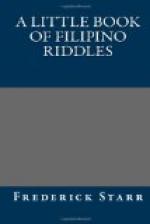A curious group are the relationship riddles, numbers 286-289, which closely resemble trick questions among ourselves. The evidence of outside influence is here conclusive in the fact that the ideas and terms of relationship in them are purely European, in nowise reflecting the characteristic Malayan system and nomenclature.
Some of the riddles are distinctly stupid. “I let the sun shine on your father’s back” seems to mean no more than that the house roof is exposed to the solar rays. It is doubtful whether this means much even in the original Tagal. Of course many of the riddles demand for their adequate understanding a knowledge of native customs, which the outsider rarely has. Thus, until one knows a common method of punishing naughty children, the riddle “I have a friend; I do not like to face him” means nothing. Perhaps the most difficult to adequately present are some plays on words. These frequently need a considerable explanation. In some of these the parts of the word to guess are concealed in or are suggested by the form of the statement and one must extract them and combine them; such are “iscopidor” and “sampaloc.” In others the play depends upon homophony, the same sound or word have different meanings. In yet a third class the answer is a smart Aleck sort of an affair, “How do you take a deer without net, dogs, spear, or other things for catching?” “Cooked.” Most inane of all, but with plenty of analogues among ourselves, are those where the answer itself is introduced into the question with the intention to mislead; “Its skin is green and its flesh is red like a watermelon.” “Watermelon.”
Filipino riddles are mostly given out by young people. When several are gathered together they will question and answer; they are much in vogue when a young gentleman calls upon his sweetheart; among Tagals and Pampangans at least the chief occasion for giving bugtong is when a little group are watching at night beside a corpse. In propounding a riddle it is not uncommon to challenge attention by repeating as witty a rhyme, which is quite as often coarse as witty. One Tagal example runs:
Bugtong co ka Piro!
Turan mo ka Baldo!
Pag hindi mo naturan
Hindi ca nang iwang;
Pag maturan mo
May tae ang puit mo.
I have a bugtong compadre
P!
Guess it compadre B!
If you cannot guess it
You have not cleaned yourself;
If you do not guess it
You are dirty.
We have mentioned two references to Malay riddles. Of the eight given in Rizal’s paper five have been given us by our informants. As Rizal’s entire paper will be reprinted in another volume of this series we have not copied the other three. Sibree’s paper is important for comparison, since it presents matter drawn from the uttermost point of Malaysia, Madagascar, which has been unaffected by Spanish influence. Sibree’s article




